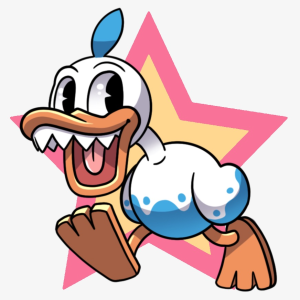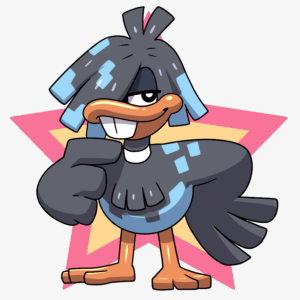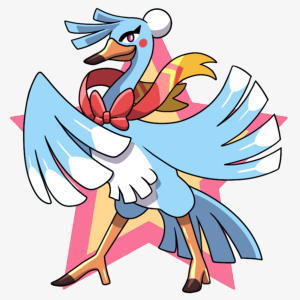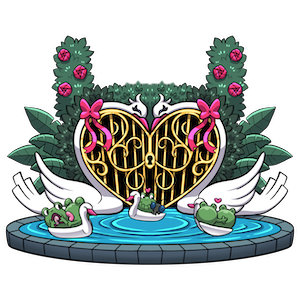
Goose Gateway
Water Coloring
Water colors have the lowest viscosity of other materials which grants them an ethereal feel.

Goose Gateway
Water Coloring
Water colors have the lowest viscosity of other materials which grants them an ethereal feel.



I see you’re getting goosebumps! Let’s just make sure it’s from excitement and not from fear from of starting watercoloring! Like a goose taking to water, you’ll soon be gliding through these activities with ease. You’ll focus on painting a color wheel, an essential tool for any artist, and on watercoloring exercises to understand all the techniques you’ll need to perfect your painting.
Just as a goose relies on its flock for direction, your color wheel will guide you through the world of hues and shades, preparing you to make any color all on your own. You’ll learn to mix primary colors to create secondary and tertiary ones. At some point, you won’t be just one of the geese following in formation, but you’ll be leading the gaggle.
Let’s get our ducks—or rather, our geese—in a row. In addition to the color wheel, you’ll also be working on various watercoloring exercises, including gradient fades, filling in evenly, and creating textures. These exercises will help you build the foundational skills needed for creating more complex compositions.
At this time, don’t be afraid to experiment! If you make a mistake, remember that even the most graceful goose occasionally ruffles its feathers. You’ll be splattering, sponging, salting, and oiling—exploring the full range of what watercolors can do. Dive into each technique with the curiosity and enthusiasm of a goose discovering a new pond.
By the end of this journey, you’ll have a vibrant color wheel and a portfolio of techniques that will serve as your artistic arsenal. So spread your wings and fly into the colorful world of watercolors!
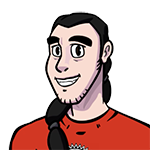
Watercoloring is an additive process which means that your brushstrokes are recorded permenantly to the your paper and can not be subtracted or removed.



Time to prep our watercolor paper! Just like a goose engaging in preening to prepare its feathers for flight, we need to stretch our special watercolor paper. Since regular paper will wrinkle up like a featherless goose in a rainstorm, we need to ensure our paper is properly stretched. This special paper has a unique texture to absorb the water and pigment, unlike flat writing paper.
To avoid a wild goose chase, we will plan out our project and avoid unnecessary chaos. Only a silly goose would not prepare. After all, if you don’t plan, you’ll cook your own goose.
Once we finish prepping our paper, it will be time to accurately draw our subject onto it before we can get our brushes wet. Think of this step as laying down the breadcrumbs for a goose to follow—every line and detail will guide your painting to success. Taking the time to draw your subject carefully ensures that the painting process will be a golden goose.
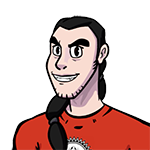
Before the advent of acrylics, Gouache was used in the graphic design industry for its fast drying qualities.
Like goslings following their mother, you’ve been guided by your teacher, but now you’re ready to spread your wings and navigate the waters of watercolor painting on your own. Watercolors are often one of the first art materials handed to fledgling students because they’re inexpensive and easy to clean. However, don’t be fooled; watercoloring is a very difficult painting method to master and should be treated with a great deal of respect. Despite its easy entry, the process of mastering it is more challenging than other art forms. It takes time to turn from an ugly duckling to a gorgeous goose!
As you embark on your watercolor painting project, remember to approach it with the determination and resilience of a migrating flock. Don’t be discouraged by setbacks or mistakes—instead, see them as opportunities for growth and learning. The flight is where the fun and beauty lie, not just in arriving at the destination. Like geese honing their flight skills through practice, your watercolor journey will be marked by experimentation and discovery.
Remember, the journey of mastering watercolor painting is just as important as the final result. Every brushstroke and wash of color contributes to your growth as an artist. So, spread your wings and embrace the creative journey ahead, knowing that with each step, you’re soaring closer to artistic mastery.
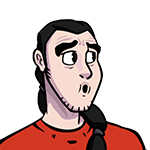
Watercoloring has always been challenging for me because it can’t be erased or covered up the way acrylics and oil paints can!
© Copyright 2014 by Oam Studios.com - Made With In Pleasanton by Omar Morineau+
Choose your art studio*
Student's Age Bracket*
Loading Content...
KIDS ART CLASSES
CHILDRENS POTTERY
ADVANCED ART
DIGITAL ART
ADULT POTTERY
BIRTHDAY PARTIES
CORPORATE EVENTS
Thank you for applying to Oam Studios Art Academy for your children's pottery lessons.
We will review your registration and respond back to you shortly.
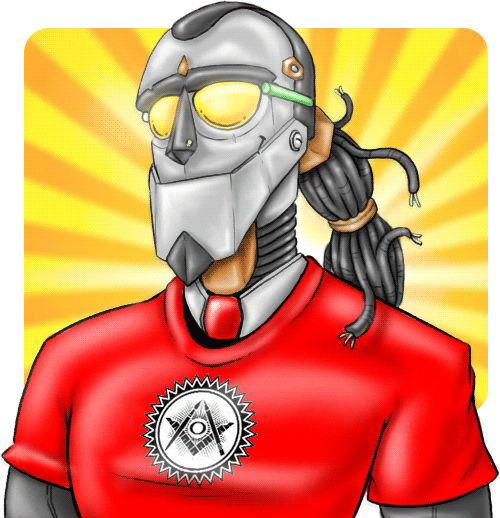
Thank you for your question!
Master Oamie is always trying to improve your experience at our website and at the art schools.
He will review your question and respond back to you quickly.
Unleash your creativity and compete with other talented artists in our art competitions. This is your chance to shine and have your work recognized.
To participate, register through our platform and submit your artwork before the deadline. Be sure to review the competition guidelines for specific details.
Art competitions provide a fantastic opportunity to gain exposure, receive feedback from professionals, and build confidence in your artistic journey. Celebrate creativity and push the boundaries of your imagination!
If your child is participating in a competition we’re not hosting, we are here to support them in preparing for their project. Our instructors will guide them with resources, feedback, and encouragement to ensure they’re set up for success.
And if they win, we’d be delighted to attend the award ceremony to show our support and celebrate their achievement together!
If you have questions or need assistance with your submission, our team is here to support you every step of the way. Don't hesitate to contact us.
We understand that life can be unpredictable, and you may need to miss a class. Our Pre-Absence policy allows students to inform us ahead of time about their absence to make appropriate accommodations.
To schedule an absence, simply notify us at least 24 hours in advance. This allows us to adjust class materials and schedules as needed.
Advance notice helps us manage resources efficiently and ensures other students can continue their learning without disruptions. It also helps us maintain the quality of education and classroom environment.
If you need assistance with scheduling a pre-absence, please reach out to our team. We're here to help make the process smooth and easy for you.
At Oam Studios Art Academy, we operate under a no-refund policy. This policy ensures fairness and consistency for all students and families.
Due to the nature of our art classes, supplies, and reserved slots, all purchases are considered final. This allows us to plan resources effectively and maintain a high-quality learning experience for everyone.
If you have questions about this policy or wish to discuss specific concerns, please feel free to contact us. We are here to assist and ensure the best possible experience for our students.
Our class durations are thoughtfully designed to align with the age and attention span of the students, ensuring an optimal learning experience.
For younger students aged 4–8, classes are typically 50 minutes, providing a balance of focus and creativity. Older students and adults benefit from longer sessions of 90–120 minutes, allowing for in-depth exploration of techniques and projects.
We offer a range of time slots to accommodate various schedules. Whether you prefer a weekday evening or a weekend afternoons, we have options to fit your families routines.
Specialized sessions, such as portfolio preparation or advanced technique workshops, may have extended durations to cover more content and practice time.
For longer classes, short breaks are included to ensure students stay engaged throughout the session and have some needed socializing with peers.
Thank you for applying to Oam Studios Art Academy for your children's art lessons.
We will review your registration and respond back to you shortly.
| Teacher Student Ratios | |
|---|---|
| Age Bracket | Ratios |
| 4 - 8 | 1:5 |
| 9 - 11 | 1:10 |
| 12 & up | 1:12 |
Grouping Students
Students are taught individually while being in a group setting. Students are grouped together by age, not by skill level.
Each student will be working on different assignments based on their placement in our curriculum and also based on the student’s preference on the subject matter.
There is no formal critiquing between students unless they are in the Studio Art Class.
One-on-One art classes provide a tailored experience focusing on individual needs. These classes offer a personalized approach for students who may require more focused attention or specialized instruction.
For students with special needs, One-on-One classes offer a supportive environment tailored to their specific requirements. These sessions ensure a pace that accommodates various abilities, with personalized strategies for success.
Neurodivergent students benefit from One-on-One art classes through adapted teaching methods that align with their unique learning styles. These classes focus on creating an inclusive and understanding space.
One-on-One art classes for adults provide an opportunity to explore artistic passions with individual attention. These sessions are designed to cater to the unique interests and skill levels of adult learners.
Group art classes offer social, sharing, and financial benefits. Students should be well-mannered and avoid disruptive behavior.
In some cases, art students may require one-on-one lessons instead of group lessons, particularly for special needs or neurodivergence.
Students interested in group classes must be able to:
1. Work independently for short periods after instruction.
2. Stay focused during class, even when teachers are assisting other students.
3. Follow the curriculum and communicate their ideas effectively to teachers.
4. Remain seated throughout class time.
At Oam Studios, art projects are allotted a time limit of 12 classes. After this, parents can decide if their child should continue the project at the studio or complete it at home. Completed projects should be returned to the studio for credit.
We emphasize quality over quantity and precision over speed. Students first practice on worksheets before applying their new skills to their final projects. Putting time into their art projects ensures that a student focuses on mastering techniques rather than rushing through multiple low-quality pieces.
Oam Studios Art Academy currently offers three payment plans to choose from.
Tuition is based on the student's age bracket and the chosen class plan.
Purchasing a larger number of classes results in greater savings.
Art supplies are provided for our art projects, except for special projects that students bring to the studio.
These may include competitions, school assignments, or other personal projects.
Additional exceptions may apply to adult or advanced classes.
There is a $50 registration fee per student or a $25 registration fee per sibling.
All sales are final, and refunds are not available.

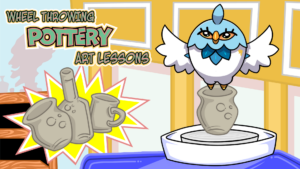
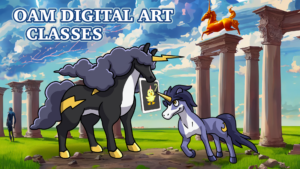
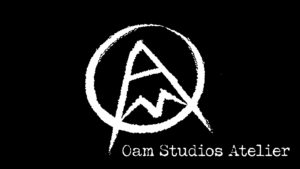
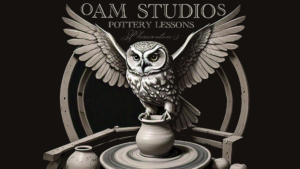
Many art schools require parents to run around purchasing art supplies that they know little about.
Worst is when they force you to purchase the art supplies from them at a marked up price!
At Oam Studios Art Academy, we provide all the supplies to the student, allowing more free time to the parents and less hassle.
As the artist, we know quality of supply needed for each project and provide what works best.
In somecases we will not be able to provide the art supplies.
For example, many of our students have school assignments that they would like to work on during their class time or a competition that they are signing up for.
There are some exceptions such as paint, brushes or pencils in which case they can readily use.
It is best to ask us before assuming.
You may need to freeze your child’s account.
Freezing is necessary when your child will be absent for an extended period due to a vacation or emergency.
Note: There’s no need to freeze accounts during the studio’s holiday breaks.
Accounts can be frozen for absences a minimum of one month, ensuring that class credits remain intact during the absence.
Students absent for one to three classes should not have their account frozen.
Text your art studio and let them know you would like to freeze your account, or do so by signing into your account on the site and clicking on your child's settings and clicking the freeze account toggle.
When an account is frozen, the student is removed from their scheduled class time.
Classes can be rescheduled after unfreezing the account, but previous class times or days may not be available.
How to Reach UsWe are happy to assist you! However, as we are often busy teaching, we kindly ask that you contact us via text message or email for non-emergency inquiries. By using text and email, we will have written record of your request which allows us to form a queue that allows us to respond to your messages more efficiently. Are administrative hours are typically before and at the end of our school day. PleasantonEmail: pleasanton@oamstudios.com Text Message: (925) 989-4756 Phone Calls: (925) 989-4756 TracyEmail: tracy@oamstudios.com Text Message: (209) 640-4406 Phone Calls: (209) 640-4406 |
No Late FeesSoon we will no longer charge late fees for class package invoices that are overdue, but currently there is a $10 late fee per week over due. Instead, if an invoice is overdue and a student attends a class, that class will be charged as a single class and an invoice will be sent out immediately upon attending the class. The previously automated class package invoice that was due can still be paid or the parents can continue at the single class rate. We will be unable to delete the single class invoice; that invoice should be paid. Late fees will apply to single class invoices at a rate of $10 per day overdue. Once the invoice with the bulk classes has been paid, the student will no longer be charged on an individual class basis. |
Trial Classes So that you and your child(ren) can experience what our art classes have to offer, a noncommital first class can be scheduled for the Art Quest Program, which covers many different art techniques and mediums. The trial class is free if the student decides not to join. This allows you the freedom to try without obligation. If they decide to join, then the trial class is considered the first class. Free trial classes do not apply to our advanced art programs. |
Scheduling Students are taught individually even though they are in small groups, resulting in many scheduling benefits to you and your child. For example, this allows students to start classes when ever they feel they are ready to. Also they can switch class day and times seamlessly since the curriculum is dependent upon your child’s progress and not on the other students or assigned teachers. To set the initial day and time, use the registration form to select your class. Other benefits include:
Our members can pause classes between sessions or by freezing their account once a year. Because we are a year round art academy, and not a semester based one, students have more flexibility for their schedule and their lessons. |
Paired by Age Students are grouped by age in small teacher to student ratios. Age bracket 5-8 We recognize that children of this age range need lots of one on one attention for their developing minds and insatiable curiosity. By being taught individually in small classes, we can cut classes while maintaining the highest standards possible Age bracket 9-11 Children of this age range are more self sufficient, becoming concerned with socializing and fitting in, and now more aware of their talent or lack of talent in differing subject matters. It’s important at this age that art remains fun, educational, disciplined, but not damaging their developing awareness of self. Age bracket 12 & Up Adolescents of this age range are highly capable of focusing on their work and delighting in their concentration. At this age they are highly aware of what they enjoy doing and no longer seeking as much social praise from their peers. Students in this range have serious issues to start focusing on that will determine their future. Regarding art, that could be an art portfolio for an art college or university whether their major is art related or not. It could also include competing in art contests, or developing the habits of success such as completing a project that they’ve begun. |
Class Credits When a guardian purchases a class package for their students, they have the option of purchasing 4 class credits or 12 class credits. Class credits are used when a student attends their class time or when they no longer have any more excused absences on their account and do not attend their class. To avoid losing a class credit, guardians and students should be sure to not go over their allotted excused absences on their account. *We do eventually hope that guardians will be able to choose the amount of class credits to purchase in bulk |
Scheduling a Make Up You should schedule a make up class if you have any make-up credits on your account. You can see if you have any on your attendance photos. You may schedule a make-up class on a day other than your regularly scheduled class days although this is dependent on availability and cannot be ensured that there is space Please text your studio location with your request for a make-up day and we will coordinate with you to complete your request or offer other alternatives. |
Profile Pages Each student at Oam Studios Art Academy recieves an online profile page that stores their account information, awards and achievements. Account Information The profile pages are super convenient for parents for several reasons:
Progress Reports On the student's profile page, guardians can quickly see their child's progress by referring to a progress wheel that depicts the percentage of the current project completed Students also will let the teacher and parent know how they feel about the current project or studio by selecting an emoji that represents their feelings. Their profile page also has behavior bars which indicate how well they are seated, concentrated, hand raising, and cleanliness. Activity Walls We update guardians by posting current progress images and critiques on the students activity walls tab Parents can ask for an update any time but we will also automatically do so when students hit certain progress percentages Parents and other members can comment on the posts or make their own posts to encourage community conversations Portfolio Tab Each student will have their art work uploaded to their portfolio tab with a custom critique Guradians and students can look back at their progress and share it with their friends and family Levels Tab Click on the levels tab from the students profile page to view all the levels of our curriculum The OamieMon creatures display in color when a student has competed that level and earned their OamieMon creature. Click on the OamieMon creatures for more information about the levels and for story information regarding the mythology. |
Oamoji Awards Art students earn several digital awards that can be traded in for physical or digital gifts 💸 For the completion of each level, students earn art money that can be spent by the student at our student stores online or in person 🧁 class cup cakes are gifted by the art teachers randomly and after 4 are collected, they become teachers apples. 4🧁 = 1💸 + 1🍎 🍎 teacher apples are earned when the student shows the very best behavior improvement of their class. 4🍎 = 1💸 + 1💎 💎 digital diamonds for being the absolute best behavec student in the whole class. 6💎 = 5💸 + 1👑 👑 class crowns are accumulated by earning 6 digital diamonds. Each crown means a visit to the art store. Gathering oamjoji awards result in more art money and higher student status. Behavior Oamojis In order to spend their earned art money, students must earn all 4 Behavior Oamojis. 🪑 The chair oamoji is earned by remaining at their seat and asking for permission to leave the table 👁 The eye oamoji is earned by concentratiing on their art project and resisting the temptations of distraction 🖐 The hand oamoji is earned when a student consistenly raises their hand and asks for permission to speak 🧼 The soap oamoji is earned when a student keeps their space organize, cleans up after themselves, and helps the teacher and classmates maintain a clean and safe studio space Competition Oamojis Additionally, student can earn more art moeny and oamojis by competing in art competitions. 🍄 The mushroom oamoji is easily earned just by participating in any online art competition. 🍄 = 5💸 + 1🧁 🌷 The flower oamoji can be earned by participating in an in-person competition and participating in the award ceremony by at least attending. 🌷 = 10💸 + 1🍎 ⭐️ The star oamji is earned when the student places second or third in any art compettiion. ⭐️ = 25💸 + 1💎 🏆 The trophy oamji is earned when a student places first in any art competition and is highly coveted. 🏆 = 50💸 + 1👑 Leveling Up Character Oamojis 🧖 After completing a level, a student is classed as an artist type. Students can multiclass depending on the way they conduct themselves as an artist during their projects 👩🚀 Art Astronauts are very intelligent and use science and math for making their art work super precise. More importantly though, there in the piazza remains a fountain named Fonte Gaia which is secretly known amongst artists as the final gateway to becoming a Master Artist. 🦸♂️ Art Heroes are very social and talkative. This can be helpful to their classmates when they focus their social skills on helping their art teacher and classmates discuss art and solving art problems. 🥷 Art Ninjas are very silent and private when they work. Art Ninjas rarely ever distract their fellow students but they have to be really careful to not be too shy. 🧙♂️ Art Wizards are very imaginative and creative students. They see the world as a magical place without limits and art allows them to explore their mystical ideas. |
